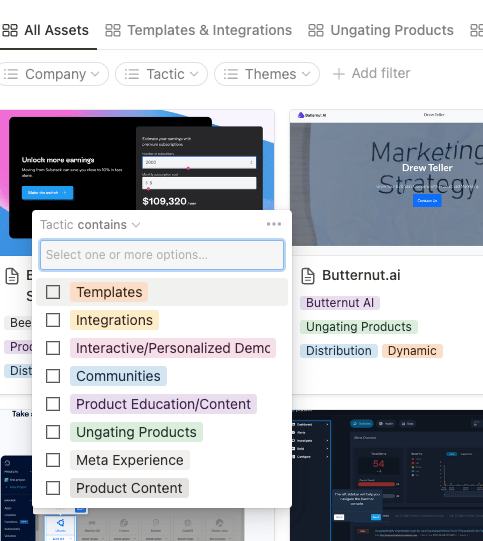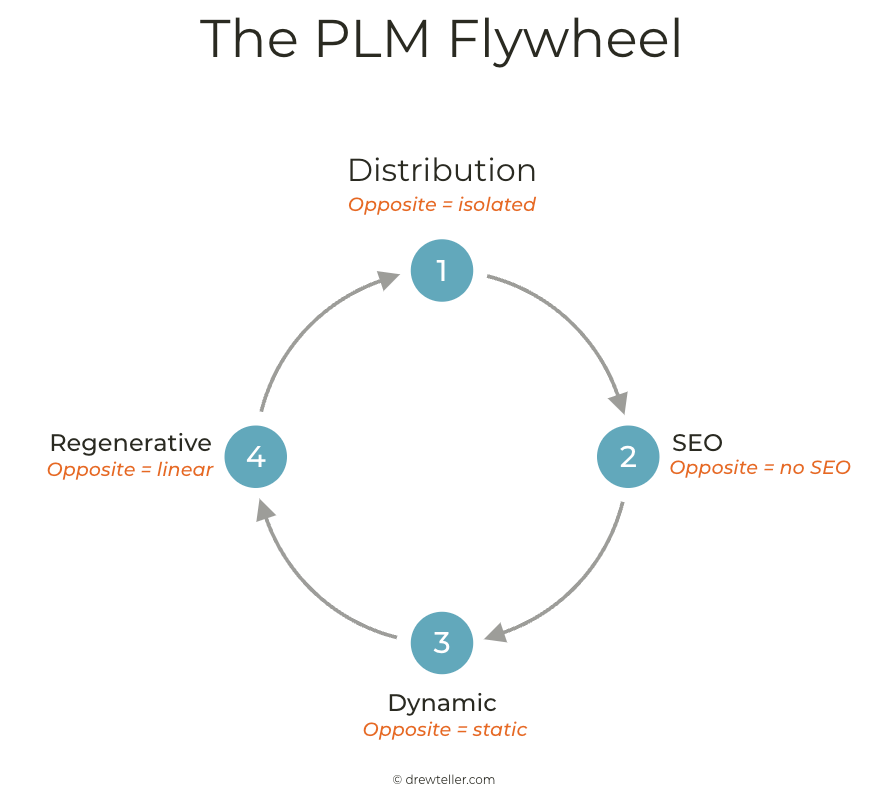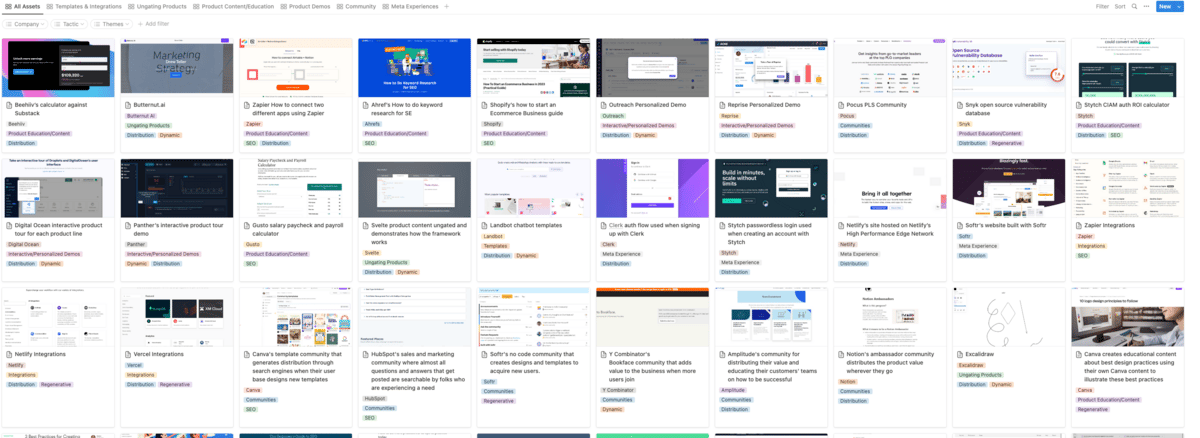In the era of PLG, traditional marketing is dying. I am here to tell you: don’t get left behind.
The future of marketing is product-led.
As a growth operator, advisor, and consultant, I have seen countless struggles with getting the right marketing strategy down as B2B/Prosumer SaaS companies try to scale PLG motions. It’s a (fun) mess and most of the time it’s backward.
Even though traditional B2B marketing is important (think ABM, demand generation, SEO, etc) → it needs to evolve with the right strategies to keep up with the fast progress of software tooling, development, and web applications coupled with PLG.
The current challenges I am seeing:
1️⃣ Products and features are being built without discovery in mind from the start
2️⃣ Marketing teams are writing content to communicate what the product is already communicating
3️⃣ We create arbitrary constraints to how products should be marketed and distributed.
4️⃣ Marketing and Product led teams are more siloed than we think. I am not talking about PMMs. I am talking about how the product roadmap includes marketing as an afterthought. Product launches, and then marketing markets. SMH 😡
Here is a comprehensive guide on why and how your company needs to embrace product-led marketing.
Table of Contents
What is Product-led Marketing
Product-led marketing (PLM) is a marketing strategy that leverages the product itself, or parts of the product, to reach potential users by way of moving up the product funnel.
Let’s break this down:
👉 Leverages the product - the product, the app, the piece of your company that your users and customers use. Think: decoupling or packaging parts of the product like templates or changelog.
👉 Reaching potential users - distribution through marketing channels, communities, and the company website. Think: distribution, SEO, virality.
👉 Moving up the product funnel - the deepest part of your product funnel is product engagement and retention. The top of the funnel is awareness or a website visit. Think: how can you bring the product upwards through the funnel with little friction?
It’s important to bridge the gap between PLG motions. Just like what Product-led sales is doing. Product-led sales is the bridge between sales-led monetization and product-led monetization. And thanks to Pocus, Madkuku, Correlated, Headsup, Endgame, etc → we have crossed into the early adoption lifecycle curve in the industry.
It’s time for PLM.

Product-led marketing bridge. Inspired by Elena Verna’s PLS bridge.
Product-led marketing is the dominant PLG-infused marketing strategy that supplements mainly acquisition motions within the growth model.
PLM is the bridge between product-led acquisition and marketing-led acquisition.
So if we are all bought in on Product-led sales, why shouldn’t we be adopting product-led marketing? Let’s get into it.
Why do we need to adopt PLM strategies?
There are several reasons why we need to adopt product-led marketing strategies.
CAC needs to drop: In PLG, you need to keep CAC low to scale a successful growth engine. Marketing channels are getting saturated and cost per acquisition is increasing due to the challenges of market-channel fits and product-channel fits. Kyle Poyar wrote a great unit economics calculation here on the truth about acquisition cost. PLM strategies are extensions of low CAC strategies to acquire users.
The PLG motion gap: We need to sequentially bridge the gap between product-led acquisition (virality, WoM, referral, invite, and casual-contact loops) and marketing-led acquisition (higher CAC demand gen, performance marketing, blog posts, etc). It is hard to just spin up virality engines when the marketing-led acquisition motion is struggling. PLM is the answer.
Collaboration and buy-in of new ideas: Innovation is required within organizational team structures. Products and features are being built without distribution in mind. While it’s not the core PM's superpower to think about distribution, there is also a gap in traditional marketing knowledge to think about distribution. A new opportunity emerges when you have PLG marketing thinking about discovery and distribution to solve innovative challenges amongst traditional marketing and product orgs.
I break down the strategies of PLM into Themes and Tactics. Let’s dive in.
Interested in starting a newsletter?
Beehiiv 🐝 is the best tool for newsletters. Free to start and they don’t take a cut of your earnings. Use my referral link for a 30-day trial + 20% OFF for 3 months.
Strategies of Product-Led Marketing (PLM)
While tactics are the actual products or “parts of the product” that are launched or “moved up through the funnel” (like templates or product content), the themes are crucial in understanding what separates a great strategy from a poor one.
The success of your PLM strategy is a function of themes multiplied by the tactic.
Strategy = f {Themes x Tactics}.
Let’s start with tactics.
Tactics
Over the last year, I have observed dozens of SaaS PLG marketing strategies. With confidence, I can empirically, anecdotally, and qualitatively categorize PLM tactics into 6 main buckets (with a bonus bucket):
Templates & Integrations (Marketplaces)
Examples: Miroverse, Figma, Softr & Webflow templates, Netlify & Vercel integration marketplaces
Interactive & Personalized Product Demos
Examples: Navattic, RepriseCommunities
Product Education & Content
Examples: AppsFlyer deep-linking guide, Ahref’s keyword strategy
Ungating Products
Examples: Butternut.ai, Coolors.co, Stackblitz
Sidecar Products
Examples: Snyk vulnerability test, Gusto’s payroll calculatorBonus: Meta Experiences → where you use the product indirectly without you realizing it as you go to the website or signup.
Examples: Stytch login flow uses Stytch, Netlify’s marketing site is hosted on Netlify
But tactics are not enough. How tactics are applied matters more than the tactics alone. You can’t just launch something and hope it just works.
What about the themes?
Themes
The themes of PLM consist of four core principles which are critically important to think about when building successful tactics. I also list the opposite of each theme because it’s important to know how you can improve a potential tactic based on its counterpart. Seeing what something is not is helpful to think more strategically.
The themes are:
Distribution 🟢
This theme focuses on meeting the users where they are, making the product more accessible and distributed across multiple channels. Distributing a tactic helps decouple the product and helps drive more discovery.
The opposite is isolation 🔴. An isolated tactic is one that is locked up only for specific users of your product or gated behind some paywall.
SEO 🟢
This theme focuses on making the product or parts of the product more discoverable on search engines, ensuring that potential users can easily find it when searching for solutions.
The opposite is no SEO 🔴. This is straightforward. Without organic search, your product or features will limit discoverability.
Dynamic 🟢
This theme focuses on ensuring that the product being marketed can adapt easily and change seamlessly, with frequent updates. Dynamic tactics utilize proper web strategies to ensure you have structured content and built-in customization.
The opposite is static 🔴. A static approach to launching a tactic would freeze the product in time, making it difficult to update or improve the tactic.
Regenerative 🟢
This theme focuses on driving growth to acquisition or engagement, ensuring that the product continues to grow and evolve over time. Flywheel or loop properties are strong whenever a PLM tactic has regenerative effects.
The opposite is linear 🔴. A linear tactic is a tactic that does not build on itself. It does not have any loop or flywheel properties for sustainable growth.
The reason why I decouple the themes from the tactics is that I am sure you have seen templates that don’t drive growth or acquisition. They don’t drive SEO or leverage a good distribution medium. I am sure you have seen blogs that don’t communicate the product and or the challenges that it solves. I am sure you have seen communities fail at being extensions of the product because there is a lack of distribution and dynamic engagement. I can go on forever, but you get the point.
It’s critical to think about existing tactics across these themes and the opposite of each theme to understand where the opportunities live. Remember, ⭐ strategies are a function of tactics multiplied by applied themes.
But I want examples!
The PLM Database with 300+ Example Tactics
I compiled an extensive database of examples of good PLM tactics. And it continues to grow! [Update as of Dec 29th, 2023, the database has moved from Notion to my website).
Each example in the database is grouped under a singular tactic. Each tactic can have strengths across the different themes of PLM. You can filter by themes too!

Filter the database by theme

Filter the database by tactic
How to Build a PLM Strategy for Your Company
There are 5 key elements for developing a PLM strategy.
Build a cross-functional team: PLM requires a coordinated effort between product, marketing, and engineering teams. Start by building a team that includes representatives from each of these areas. PLM requires marketing leadership buy-in. The friction will come from marketing, not product, and not growth.
Identify key product-led marketing themes and tactics: Conduct an audit of your current PLG marketing efforts and identify areas where product-led marketing themes can be applied. Think themes and tactics. What are some quick wins and what are long-term strategic motions? Look to align with the product roadmap to help build the distribution from the start.
Establish metrics: Define clear metrics and KPIs that align with the overall business goals and the specific initiatives being implemented. Set benchmarks and targets for each metric to track progress and measure success. Example metrics: new user acquisition, existing user traffic (engagement).
Experiment and iterate: Start small by launching new tactics or strategies as experiments rather than large-scale campaigns. Set up A/B tests or other experiments to compare the performance of different tactics. Monitor performance closely and adjust strategies as needed based on the data and feedback. Think about taking something small like your product changelog and deploying it on the marketing site.
Foster a culture of experimentation: Encourage your team to experiment with new tactics and strategies. Create a culture of continuous improvement to drive ongoing growth and success.
Transitioning and implementing a new strategy is not easy. Not only are you up against competing forces, but you also have to influence and convince stakeholders that PLM will work.
You need to start small.
Start with the PLM Flywheel
The best place to start building a successful tactic is to adopt the themes in order of the PLM Flywheel.
Not all themes or principles are required for a successful PLM tactic, but looking at the data empirically, distribution is the first theme adopted, then SEO (organic reach), then having dynamic elements, and finally, regenerative growth.

The PLM Flywheel
Each theme (distribution, SEO, dynamic, and regenerative) has an opposite. The opposite is the non-ideal state and could be the current state of some products being marketed. This is where you start!
That strategy sounds nice, but how can I start now and find quick wins?
Start with locating any existing tactics that are sitting in the opposite bucket, starting with Distribution → in this case, start with isolated parts of the product. Then move into the next opposite bucket → no SEO. Then move into the next opposite bucket → Static. Then move into the last opposite bucket → Linear.
Start by turning these “opposite states” into strong PLM tactics by adopting the right themes or the “right states”. In other words, take existing tactics and apply the PLM themes. But what does this look like?
Here is a list of example small wins you can do for various tactics:
Take private sales demos and turn them into a create interactive product demo that sits on the marketing site (Isolated → Distributed)
Take integrations in the product and create separate web pages for each integration so that each is discoverable on search (no SEO → SEO)
Add social sharing opportunities to templates so that new users join and use the product (Linear → Regenerative)
Take your product changelog and put it on the marketing site so it’s more discoverable and can be updated more regularly (Isolated & Static → Distributed & Dynamic)
Turn your community into a hackathon to generate product content (no SEO & Linear → SEO + Regenerative)
Create an ROI guide or product calculator convincing users to buy your product because it will save them money (Isolated → Distributed, and maybe SEO too!)
What are the differences between PLM and traditional marketing?
You may be thinking;
What’s the difference between product-led marketing and traditional B2B marketing?
Where does product marketing (PMM) fit into all this?
How is PLM fit into PLG?
Let’s get into it.
What’s the difference between product-led marketing and traditional marketing?
In traditional marketing, it’s all about the following:
Creating demand for products and services
Applying a channel and campaign first thinking - ads, organic, partnerships, blogs, etc.
Growing disconnect from the product in the roadmap planning
Have product and marketing execution processes are siloed
Explain why the product solves the problem
In product-led marketing (PLM), it’s all about:
Leveraging the product to drive acquisition and engagement
Product-first thinking (tactics) - templates, integrations, demos, communities, changelogs, etc
The product is the core medium that is being communicated or "demonstrated" to the end-user
Growth marketing and growth product are in alignment (growth marketing is typically on the product team).
Shows how (not why) to solve the problem.
Where does PMM fit into all this?
Product marketers’ role doesn't actually change. They continue to write, communicate, and be the voice of the customer across PLM strategies.
Product marketing is a consistent function throughout the comparison between marketing and PLM.
PMMs are usually the bridge between the product and marketing communication channels such as the blog, sales collateral, campaigns, and in-app communication
PMMs are layered mediums that have a crucial, important job to ensure personalization and user journeys align with core ICPs
PMMs are people who perform product marketing functions, vs PLM is the strategy.
How does PLM fit into PLG?
PLG is a company growth model that leverages the product to acquire, retain, and monetize users.

In Elena Verna’s growth matrix above, PLM is the red dot that sits between Product led acquisition and marketing-led acquisition. The red dot also matches the PLM bridge (here is again for reference):

PLM is a marketing strategy, not a motion. It's based on reach, where the product is being distributed. The product demonstrates how (not why) it solves a user's problem. PLM strategies assist PLG distribution models.
Conclusion
Product-Led Marketing (PLM) is a marketing strategy that leverages the product itself, or parts of the product, to reach potential users by way of moving up the product funnel.
The success of a PLM strategy is a function of themes and tactics. There are four core themes in PLM: distribution, SEO, dynamic, and regenerative. PLM tactics can be categorized into 5 main buckets: templates & integrations, interactive & personalized product demos, communities, product education & content, and ungating products.
This is the future of B2B marketing in the era of PLG as traditional marketing is becoming ineffective, especially in the B2B/Prosumer SaaS industry.
By adopting PLM strategies, businesses can reduce CAC, bridge the gap between product-led acquisition and marketing-led acquisition, and encourage collaboration and buy-in of new ideas.
To build a successful PLM strategy, businesses should build a cross-functional team, identify key product-led marketing themes, establish metrics, and foster a culture of experimentation.
Get started by locating any existing tactics that are sitting in the opposite bucket of each theme on the PLM Flywheel. What are you waiting for?
Let’s go! 🚀
Resources & Background Reading:
Here is a list of links for background information on Product-led marketing.
When I wrote my Master’s Thesis on Strategic Thinking, one thing I learned is that I must have supporting research on any given topic.
Please note that I did not invent Product-led marketing, but I have taken into account lots of previous resources and I believe this guide to PLM is different, and brings a deeper empirical dive into the approach to Product-led Marketing.
Product-led Marketing Webinar hosted by Drew Teller & Userled
The guide to Product led marketing - Kyle Poyar with Open View
Product Led Marketing - Lenny Richinsky + Kyle Poyar
What is product-led marketing - Pendo
What is product-led marketing - ProductLed
Thanks for being a subscriber!
Was this forwarded to you? Subscribe with one click.
See you next time! 👋

